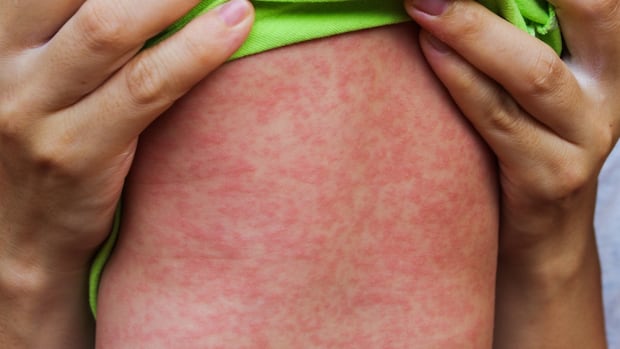[
Medical experts say Saskatchewan residents should remain vigilant about the threat of measles.
The news comes as Alberta reported on Monday it has confirmed 1,314 measles cases this year, which is higher than the number reported in the entire United States.
In contrast, Saskatchewan has had just 60 confirmed cases this year — and as of July 9 there had not been a single case reported in the province in the preceding 21 days.
From 2015 to 2024, there were a total of two cases recorded in Saskatchewan.
Dr. Jasmine Hasselback, a medical health officer with the Saskatchewan Health Authority (SHA), acknowledged the province has had “a little bit of a respite” in the number of cases but added that more are expected, pointing to an exposure notice issued on Friday.
“The reality is you really should be acting as if you’ve got potential for seeing measles in all sorts of places,” Hasselback said.
Joseph Blondeau, a clinical microbiologist at Royal University Hospital in Saskatoon, offered a similar assessment.
Blondeau said that although the number of cases in Alberta is producing headlines, measles remains a threat in Saskatchewan.
“We’re likely still going to see cases in Saskatchewan going forward. I don’t think that this problem is over yet,” Blondeau said on Monday.
Alberta’s measles explosion
As the number of measles cases in Alberta has ballooned, medical experts in the province have continued to monitor the spread of the disease.
That includes Dr. Lynora Saxinger, an infectious disease specialist at the University of Alberta,
“We haven’t seen numbers like this in 25 years. As a matter of fact, right now we’re well above the last 25 years’ total for all of Canada in Alberta,” Saxinger said.
Alberta has the highest rate of the disease per capita in North America. In an interview with CBC News, Dr. Lynora Saxinger explained how the high caseload is impacting the health-care system in the province.
Craig Jenne, a professor in the department of microbiology, immunology and infectious diseases at the University of Calgary, said one of the reasons for the dramatic increase in the spread of the disease in Alberta is a drop in vaccination rates.
Jenne said herd immunity requires a vaccination rate of 95 per cent or higher. In Alberta, the vaccination rate has dropped below 50 per cent.
That means when a new measles case is introduced to a community, likely through travel, it can spread from person to person in the community.
“Unfortunately, that’s what we’re seeing in Alberta, and vaccine rates are simply too low to stop that spread,” said Jenne.
Alberta an ‘early-warning’
It’s not clear what the current vaccination rates are in Saskatchewan.
The province’s measles website does not provide data on measles vaccination rates in the province and the Ministry of Health did not respond to a request for those numbers.
Another factor Saskatchewan needs to be aware of is the transmissibility of measles.
“We think back to the days of COVID and all of the public health restrictions that were put in place in order to prevent transmission of COVID,” said Blondeau.
“The measles virus is on a magnitude very, very different than COVID. In terms of its transmissibility, it’s much more highly transmissible.”
Saxinger said the transmissibility of measles is a concern in Alberta, especially with large events, such as the Calgary Stampede, just wrapping up.
Only time will tell if that could produce even more cases, Saxinger said.

Jenne said that Alberta is not unique and should serve as an “early warning” to other provinces..
“There is a a very narrow and fleeting window right now to raise those numbers and be able to get other jurisdictions protected before measles gains a foothold.”
The SHA is recommending everyone get fully vaccinated against measles. More information on that process in Saskatchewan is available on its website.

